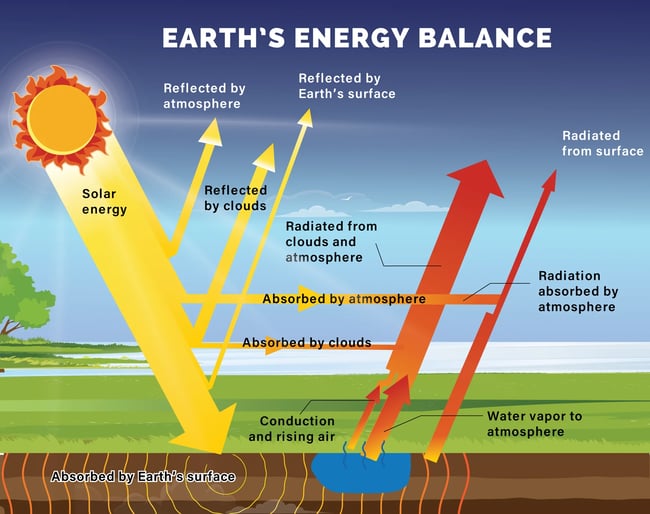Developing and implementing novel solutions to climate change has quickly become one of the world’s top priorities. Climate change indicators continue to break records with each passing year, highlighting the urgency of the situation. While most efforts focus on reducing greenhouse gas emissions, the world faces a reality where that alone may not be enough.
Experts are reviewing additional methods that may play a part in solving climate change. Solar geoengineering is one such area of exploration, taking a different approach to fixing the Earth’s energy balance.
Climate Change and Earth’s Energy Balance
Earth’s energy balance is an integral part of understanding climate change. The Earth constantly receives energy from the sun but also radiates heat back into space. This balance dominates the planet’s climate, with other factors, such as geothermal heat from the core, being negligible in comparison.
Some of the sun’s energy is reflected immediately, and some is radiated away from the Earth as infrared radiation, as any warm object produces. If the energy leaving is less than the energy coming in, then the total amount of energy held by the Earth increases, raising temperatures.

Greenhouse gas emissions upset the balance through the greenhouse effect. Higher levels of carbon dioxide and other greenhouse gases absorb heat radiating from the Earth, acting as insulation. This effect doesn’t impact sunlight coming in, only infrared radiation due to its higher wavelength. The result is the global temperature increase we know as climate change.
Solar Geoengineering Solutions
Reducing greenhouse gas emissions by switching electrical generation, transportation, and other emissions from fossil fuels to renewable sources is the primary focus of modern action against climate change. However, other options are being explored to work alongside these efforts or to achieve faster results than any gradual reduction could deliver.
Solar geoengineering’s core concept is simple: alter the Earth’s energy balance to reduce climate change in ways other than reducing greenhouse gas emissions. A variety of geoengineering examples have the potential to reflect incoming solar energy, shifting the balance by stopping energy from sunlight being absorbed in the first place.
Increasing Ground Surface Albedo
One such method involves increasing ground surfaces’ albedo (fraction of sunlight that a given object reflects). White paint can reflect as much as 80 percent of incoming sunlight, while black paint reflects just 5 percent. Using different colors and materials in infrastructure with a high exposed surface area could make a considerable difference.
Roofing and pavement are among the two most common candidates for increased albedo. They take up much of the ground surface in developed areas and are typically dark in color. Using lighter coloring through painting or material additives could help shift the Earth’s energy balance if implemented widely. Further benefits include reduced energy use for air conditioning in homes with white roofing.
These methods see some use already today. Other potential methods include generating artificial snow to increase albedo in areas with the appropriate temperatures and even creating crops with a higher albedo. However, these and many other options require careful consideration of other environmental impacts.
Marine Cloud Brightening
Another proposed method is marine cloud brightening geoengineering. This method proposes to increase the reflectivity of marine clouds over the ocean and extend their lifespan to reflect more sunlight. Clouds already play an essential role in the energy balance by naturally reflecting sunlight, but certain processes could increase their effectiveness.
Releasing cloud-condensing nuclei into the atmosphere could allow water droplets to form around them. This effect is already triggered unintentionally by ships crossing the ocean. As they release combustion emissions into the atmosphere, particles provide a foundation for clouds to grow. Satellite images show that these clouds are also noticeably brighter, showcasing the potential results of a large-scale implementation.
This solution could also see use in more niche applications. Marine cloud brightening on a large scale could shift the Earth’s energy balance, but on a local scale, it can also regulate temperature. Enhanced clouds over critical areas, such as the Great Barrier Reef, could reflect sunlight to protect coral and other sensitive marine life.
Stratospheric Aerosol Injection
Stratospheric aerosol injection is another potential solar geoengineering solution that would release particles into the stratosphere, the second layer of Earth’s atmosphere. This would increase the fraction of incoming sunlight reflected by the atmosphere. The process is similar to “volcanic winters,” where volcanic eruptions push massive amounts of material into the atmosphere and cause temporary global cooling periods spanning years.
Aerosol injection geoengineering spraying would insert reflective particles into the atmosphere using methods such as airplanes, blimps, balloons, or artillery. Various sulfur compounds are the prime candidates for this application, and they are one of the key components involved in volcanic cooling as well.
There are serious concerns about the environmental impact of such a solution. Organizations worldwide have already put so much effort into monitoring and controlling air pollution. Introducing particles to the atmosphere on such a vast scale could lead to issues such as acid rain and other consequences we don’t yet know about.
Space Sunshades
Some solutions seek to stop sunlight before it reaches the atmosphere at all. Space sunshades are a theoretical solution that would see many small satellites shading the Earth. In most proposals, the satellites would orbit the sun at the L1 Lagrange point, where they would always stay in between the sun and the Earth.
Some versions of the concept would deflect sunlight directly using large, thin materials akin to solar sails. Other concepts would instead make use of fine grills that diffuse sunlight rather than reflecting it. This slightly alters the angle, which makes a major difference given the distance between the satellites and the Earth.
While some studies point to the amount of shading to prevent climate change being as low as 1.7 percent, that would still be a monumental feat. The sheer number of satellites required would cost trillions from the outset, along with hundreds of billions in upkeep. This type of project would eclipse the scope of previous space endeavors, such as the Apollo program, many times over. Even after considering these economic hurdles, many of the technologies required simply don’t exist yet.
Could Solar Geoengineering Work?
Today, many experts believe that some form of solar geoengineering could play a role in a larger strategy to combat global warming. The US government is currently requesting proposals for such alternative solutions so these solar geoengineering programs could become a reality in the near future. However, many environmental, economic, and ethical questions must be answered before moving forward with any solar geoengineering project.
One of the most prominent issues raised by experts is that these solutions could divert attention away from more practical and immediate climate change interventions. Instead of focusing on improving energy management and tracking greenhouse gas emissions, the world might continue on its current course in the hopes of some alternative solution on the horizon.
While solar geoengineering may not be suitable as the primary focus for climate change intervention, it could still play an important role. Shifting the energy balance in favor of a cooler climate may be necessary, even if greenhouse gas goals are met, and could deliver rapid results to stave off the worst of an impending climate crisis.
Contributing Scientists of This Article:





April 4, 2024
Comments